
Felidae is a family of mammals in the order Carnivora, colloquially referred to as cats, and constitutes a clade. A member of this family is also called a felid. The term "cat" refers both to felids in general and specifically to the domestic cat.

The cheetah is a large cat native to Africa and central Iran. It is the fastest land animal, estimated to be capable of running at 80 to 128 km/h with the fastest reliably recorded speeds being 93 and 98 km/h, and as such has several adaptations for speed, including a light build, long thin legs and a long tail. It typically reaches 67–94 cm (26–37 in) at the shoulder, and the head-and-body length is between 1.1 and 1.5 m. Adults weigh between 20 and 65 kg. Its head is small, rounded, and has a short snout and black tear-like facial streaks. The coat is typically tawny to creamy white or pale buff and is mostly covered with evenly spaced, solid black spots. Four subspecies are recognised.
Panthera is a genus within the family Felidae that was named and described by Lorenz Oken in 1816 who placed all the spotted cats in this group. Reginald Innes Pocock revised the classification of this genus in 1916 as comprising the tiger, lion, jaguar, and leopard on the basis of common cranial features. Results of genetic analysis indicate that the snow leopard also belongs to the genus Panthera, a classification that was accepted by IUCN Red List assessors in 2008.

Acinonyx is a genus within the cat family. The only living species of the genus, the cheetah, lives in open grasslands of Africa and Asia.
The term "big cat" is typically used to refer to any of the five living members of the genus Panthera, namely the lion, tiger, jaguar, leopard, and snow leopard, as well as the non-pantherine cheetah and cougar. Except for the latter three, these species are able to roar.

Homotherium is an extinct genus of machairodontine saber-toothed cats, often termed scimitar-toothed cats, that inhabited North America, South America, Eurasia, and Africa during the Pliocene and Pleistocene epochs, existing for approximately 4 million years.
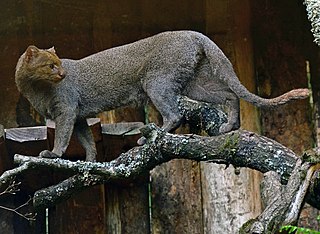
The jaguarundi is a wild cat native to the Americas. Its range extends from central Argentina in the south to northern Mexico, through Central and South America east of the Andes. The jaguarundi is a medium-sized cat of slender build. Its coloration is uniform with two color morphs, gray and red. It has an elongated body, with relatively short legs, a small, narrow head, small, round ears, a short snout, and a long tail, resembling mustelids in these respects. It is around twice as large as a domestic cat, reaching nearly 36 cm (14 in) at the shoulder, and weighs 3.5–7 kg (7.7–15.4 lb).
Metailurini is an extinct taxonomic tribe of large saber-toothed cats that lived in Africa, Asia, Europe, and North America from the Miocene to the Pleistocene.
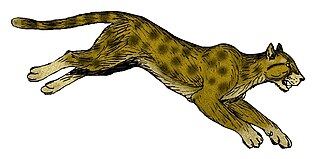
The American cheetah is either of two feline species of the extinct genus Miracinonyx, endemic to North America during the Pleistocene epoch and morphologically similar to the modern cheetah. These cats were originally known from fragments of skeletons, but nearly complete skeletons have been recovered from Natural Trap Cave in northern Wyoming.
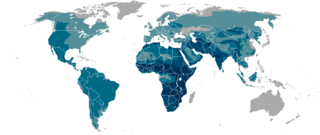
The Felinae are a subfamily of the family Felidae. This subfamily comprises the small cats having a bony hyoid, because of which they are able to purr but not roar.

Leopardus is a genus comprising eight species of small cats native to the Americas. This genus is considered the oldest branch of a genetic lineage of small cats in the Americas whose common ancestor crossed the Bering land bridge from Asia to North America in the late Miocene.

Pantherinae is a subfamily within the family Felidae; it was named and first described by Reginald Innes Pocock in 1917 as only including the Panthera species. The Pantherinae genetically diverged from a common ancestor between 9.32 to 4.47 million years ago and 10.67 to 3.76 million years ago.
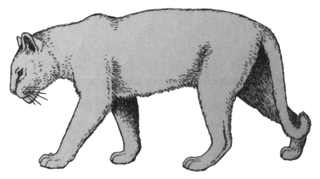
Panthera gombaszoegensis, also known as the European jaguar, is a Panthera species that lived from about 2.0 to 0.35 million years ago in Europe. The first fossils were excavated in 1938 in Gombasek, Slovakia.
Panthera leo fossilis is a fossil cat of the genus Panthera, which was first excavated near Mauer in Germany, and lived during the Upper Pleistocene. Bone fragments of P. l. fossilis were also excavated near Pakefield in the United Kingdom, which are estimated at 680,000 years old. Bone fragments excavated near Isernia in Italy are estimated at between 600,000 and 620,000 years old. The first Asian record of a fossilis lion was found in the Kuznetsk Basin in western Siberia and dates to the late Early Pleistocene.

Puma is a genus in the family Felidae that contains the cougar, and may also include several poorly known Old World fossil representatives. In addition to these potential Old World fossils, a few New World fossil representatives are possible, such as Puma pumoides and the two species of the so-called "American cheetah", currently classified under the genus Miracinonyx.

Feliformia is a suborder within the order Carnivora consisting of "cat-like" carnivorans, including cats, hyenas, mongooses, viverrids, and related taxa. Feliformia stands in contrast to the other suborder of Carnivora, Caniformia.
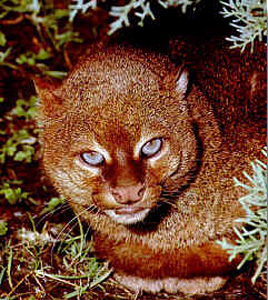
The Gulf Coast jaguarundi is a population of the jaguarundi. Two of these populations—the Gulf Coast jaguarundi and the Sinaloan jaguarundi—are considered endangered and were put on the endangered list on June 14, 1976. These cats are placed under the family Felidae and the subfamily Felinae because of their small size. As of 2017, the Cat Classification Taskforce of the Cat Specialist Group does not recognise any subspecies of jaguarundi.

Puma pardoides, sometimes called the Eurasian puma or Owen's panther, is an extinct prehistoric cat. It was long regarded as a primitive species of leopard. Recent work however has shown that Panthera pardoides and Panthera schaubi are actually the same species, and are probably not pantherine at all, but a member of Felinae related to the cougar, making them more properly classified as Puma pardoides.
Machairodontini is an extinct tribe of large saber-toothed cats of the subfamily Machairodontinae, that lived in Europe, Asia, Africa, and North America, during the late middle Miocene.

















